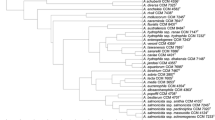Abstract
In order to confirm the taxonomic position of environmental strains determined based on their biochemical, cultural, and morphological characteristics, molecular genetic identification was carried out. A number of problems in identification of microorganisms were shown to be associated with contamination of the cultures in the course of isolation. Advantages of a comprehensive approach—combining 16S rRNA gene sequencing with a set of biochemical, cultural, and morphological parameters—for identification of microorganisms isolated from environmental objects and clinical samples are discussed.
Similar content being viewed by others
References
Woo, P.C.Y., Cheung, E.Y.L., Leung, K.W., and Yuen, K.Y., Identification by 16S ribosomal RNA gene sequencing of an Enterobacteriaceae species with ambiguous biochemical profile from a renal transplant recipient, J. Diagn. Microbiol. Infect. Dis., 2001, vol. 39, pp. 86–93.
Woo, P.C.Y., Lau, S.K.P., Woo, G.K., Fung, A.M., Ngan, A.H., Hui, W.T., and Yuen, K.Y., Seronegative bacteremic melioidosis caused by Burkholderia pseudomallei with ambiguous biochemical profile: clinical importance of accurate identification by 16S rRNA gene and groEL gene sequencing, J. Clin. Microbiol., 2003, vol. 41, no. 8, pp. 3973–3977.
Sanitary bacteriological investigation by impedance splitting method, Metod. Ukaz. MUK, 4.2.2578-10, 19.02.2010.
Revetta, R.P., Pemberton, A., Lamendella, R., Iker, B., and Santo Domingo, J.W., Identification of bacterial populations in drinking water using 16 rRNA-based sequence analyses, J. Water Res., 2010, vol. 44, no. 5, pp. 1353–1360.
Chèneby, D., Philippot, L., Hartmann, A., Hénault, C., Germon, J.C., 16S rDNA analysis for characterization of denitrifying bacteria isolated from three agricultural soils, FEMS Microbiol. Ecol., 2000, vol. 32, no. 2, pp. 121–128.
Tang, Y.W., Ellis, N.M., Hopkins, M.K., Smith, D.H., Dodge, D.E., and Persing, D.H., Comparison of phenotypic and genotypic technique for identification of unusual aerobic pathogenic gram-negative bacilli, J. Clin. Microbiol., 1998, vol. 36, pp. 3674–3679.
Woo, P.C.Y., Fung, A.M.Y., Lau, S.K.P., Hon, E., and Yuen, K.Y., Diagnosis of pelvic actinomycosis by 16S ribosomal RNA gene sequencing and its clinical significance, J. Diagn. Microbiol. Infect. Dis., 2002, vol. 43, pp. 113–118.
Relman, D.A., The identification of uncultured microbial pathogens, J. Infect. Dis., 1993, vol. 168, pp. 1–8.
Rosero J.A., Strosová L., Mrázek J., Fliegerová K., Kopecny J. J. PCR detection of uncultured rumen bacteria, J. Folia Microbiol. (Praha), 2012, vol. 57, no. 4, pp. 325–330.
Buchan, B.W., Riebe, K.M., and Ledeboer, N.A., Comparison of the MALDI Biotyper system using Sepsityper specimen processing to routine microbiological methods for identification of bacteria from positive blood culture bottles, J. Clin. Microbiol., 2012, vol. 50, no. 2, pp. 346–352.
Saffert, R.T., Cunningham, S.A., Ihde, S.M., Jobe, K.E.M., Mandrekar, J., and Patel, R., Comparison of Bruker Biotyper matrix-assisted laser desorption ionization-time of flight mass spectrometer to BD Phoenix automated microbiology system for identification of gram-negative bacilli, J. Clin. Microbiol., 2011, vol. 49, no. 3, pp. 887–892.
Woo, P.C.Y., Ng, K.H.L., Lau, S.K.P., Yip, K.T., Fung, A.M.Y., Leung, K.W., Tam, D.M.W., Que, T.L., and Yuen, K.Y., Usefulness of the MicroSeq 500 16S ribosomal DNA-based bacterial identification system for identification of clinically significant bacterial isolates with ambiguous biochemical profiles, J. Clin. Microbiol., 2003, vol. 41, no. 5, pp. 1996–2001.
RF Patent RF 2218396, 2003.
Author information
Authors and Affiliations
Corresponding author
Additional information
Original Russian Text © S.O. Korshunov, A.V. Gorovtsov, T.G. Faleeva, S.N. Gorbov, I.V. Kornienko, 2014, published in Mikrobiologiya, 2014, Vol. 83, No. 4, pp. 451–455.
Rights and permissions
About this article
Cite this article
Korshunov, S.O., Gorovtsov, A.V., Faleeva, T.G. et al. Comparison of biochemical and molecular genetic approaches for identification of environmental strains. Microbiology 83, 376–380 (2014). https://doi.org/10.1134/S0026261714040109
Received:
Published:
Issue Date:
DOI: https://doi.org/10.1134/S0026261714040109




